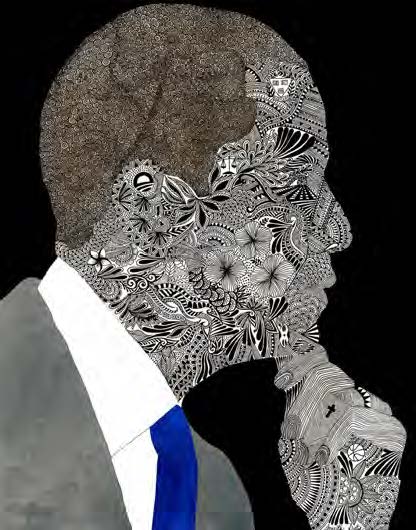Critical MAS: Patterns of memory – Patterns of hope

Written by Kathleen Caprario
I make my way through the precisely drawn foliage, visually pushing deeper into the repeated organic shapes that fill the silhouetted subject’s form. The compulsive quality of the inked line-work leads me on as I traverse what seems like a treasure map or a “Where’s Waldo” picture. I follow the various linear patterns that weave together to create a complex visual pattern with hidden items related to the work’s subject that, when found, give me the same feeling of satisfaction and surprise as if I’d successfully filled my basket at an Easter Egg Hunt or won a prize.
I take a few steps back and adjust my gaze from the close-up micro view to the big picture macro view. The gestalt of the well-known subject, the 44th President of the United States, Barack Obama, is clearly recognizable and appropriated from a popular photograph taken early in the Obama Administration. Amrita Dutia reinterprets this media-saturated image as an intimate hand-generated meditation that subverts its original position within the public domain and locates it in personal proximity to the viewer. Her investment in her subject as a man, a movement and an aspiration is evidenced in her meticulous watercolor and ink technique. Dutia employs a restrained and subdued palette of grays and blacks to create a sense of contemplation that does not argue with Obama’s thoughtful, hand-on-chin pose. Even the bright white of the subject’s shirt collar and vibrant blue of his necktie do not distract us from the unity of the work but serve to punctuate its subject’s quiet strength and power.
The portrait has long been an art form associated with respect, remembrance and status. It is a means to capture the visage and essence of a person at a particular moment in their life and that we hold, as the viewer, in a state of unchanging and protected stasis. The silhouette was a genteel tradition in American art history, and it was often used for family portraits and book illustrations. The contemporary African American artist, Kara Walker, whose room-size, black cut-paper tableaux explore race, gender, violence, sexuality and identity, reference the form of silhouette portraits once popular in the Antebellum Period to create her searing indictments of American society. Dutia also quotes the form of silhouette portraits guaranteed to have once decorated the drawing rooms and parlors of plantation houses across the American South. But rather than a critique of her subject, Dutia assumes the form in order to portray the first African American president with gratitude and hope.
Dutia’s opinion of and respect for her subject is obvious but not overstated or didactic. Her graphic and economic use of compositional shapes juxtaposed with her delicate, signature use of pattern echoes her Southeast Asian Indian background. Amrita Dutia creates a subtle tension within her “Obama Portrait- 2019” that keeps me re-entering the work to see what new delight and insight I might find there – and hope.
To learn more about the writing in the Critical MAS series, go to Critical MAS: Introduction.